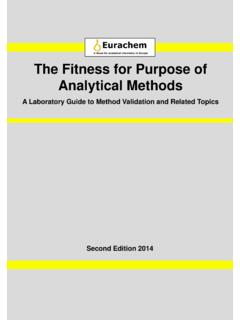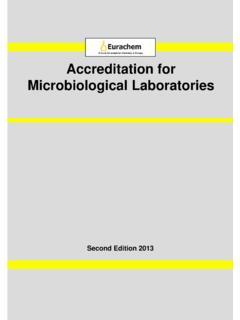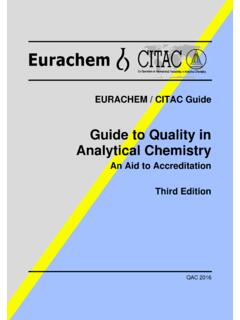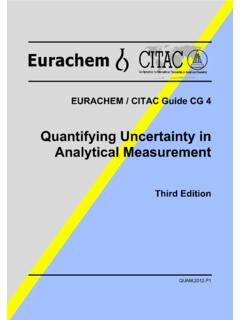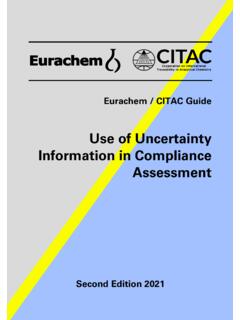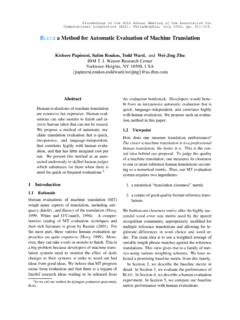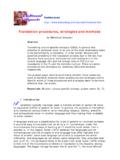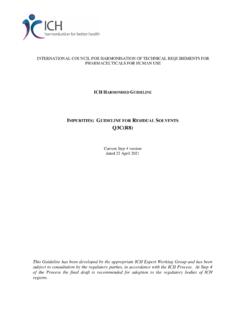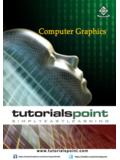Transcription of Blanks in Method Validation - Eurachem
1 Blanks in Method Validation Supplement to Eurachem Guide The Fitness for Purpose of Analytical methods First Edition 2019 A focus for analytical chemistry in Europe Blanks in Method Validation Supplement to Eurachem Guide The Fitness for Purpose of Analytical methods First edition 2019 Acknowledgements This document has been produced by members of the Eurachem Method Validation Working Group. Those who have contributed to this supplement are listed below. Project group Vicki Barwick LGC (UK) Bur u Bini i UME (TR) Helen Cantwell (Editor) The State Laboratory (IRL) John Clancy Henkel Ireland (IRL) Pieter Dehouck European Commission (EU) Elin L. F. Gjengedal Norwegian University of Life Sciences (NO) Emanuela Gregori Istituto Superiore di Sanit (IT) Anders Karlsson RISE Research Institute of Sweden (SE) Guy Lamon SGS (BE) Pedro P. Morillas Bravo Canal de Isabel II (ES) Ulf rnemark Emendo Dokumentgranskning (SE) Marina Patriarca Istituto Superiore di Sanit (IT) Francisco Raposo CSIC (ES) Lorens P.
2 Sibbesen (chair) Labquality International (DK) Isabelle Vercruysse BELAB (BE) Perihan Yolci meroglu Bursa Uludag University (TR) Recommended citation This publication should be cited* as: H. Cantwell (ed.) Blanks in Method Validation - Supplement to Eurachem Guide The Fitness for Purpose of Analytical methods , (1st ed. 2019). Available from *Subject to journal requirements Blanks in Method Validation Eurachem Supplement Blanks in Method Validation English edition First edition 2019 Copyright 2019 Copyright in this document is held by the contributing authors. All enquiries regarding reproduction in any medium, including translation, should be directed to the Eurachem secretariat. Blanks in Method Validation Eurachem Supplement MV Blanks 2019 i Contents Foreword 1 1 Introduction and scope 3 2 Types and uses of Blanks in Method Validation 4 Calibration blank 4 Procedural blank 4 Reagent blank 4 Solvent blank 4 Sample blank 4 Approaches to dealing with situations where no suitable sample blank is available 5 Bibliography 7 Blanks in Method Validation Eurachem Supplement MV Blanks 2019 ii Blanks in Method Validation Eurachem Supplement MV Blanks 2019 Page 1 Foreword The Fitness for Purpose of Analytical methods - A Laboratory Guide to Method Validation and Related Topics (2nd ed.)
3 Was published in 2014. Since then the Method Validation Working Group has identified areas where extra guidance would be appropriate. This extra guidance has been prepared in the form of supplementary documents. This supplementary document is not intended to be used in isolation; it should be used in conjunction with the Guide. Blanks in Method Validation Eurachem Supplement MV Blanks 2019 Page 2 Blanks in Method Validation Eurachem Supplement MV Blanks 2019 Page 3 1 Introduction and scope Blanks are an important tool and are used in the determination of most performance characteristics during a Validation process (see section in the Guide [1]). They are also often included in each analytical run during routine use of the measurement procedure. There are many different types of Blanks and the analyst must consider which Blanks to include during preparation of the Validation plan.
4 The aim of this document is to describe the different kinds of Blanks which may be used during Method Validation and to provide guidance for situations where it may be difficult to obtain a suitable blank matrix. Not all Blanks discussed in this document are necessary for every Validation and Blanks used during routine use of the Method to address baseline correction, do not fall under the scope of this document. It is worth noting that certain techniques, such as chromatography, rely on detecting a peak above noise. For the determination of certain performance characteristics, limit of detection (LOD) and limit of quantification (LOQ) for example, it is necessary, therefore, to use a sample containing a low level of analyte rather than a blank. Further guidance on this is provided in the Guide in section Figure 1 shows the different types of Blanks classified by their general intended use (calibration Blanks , procedural Blanks ) and by composition (reagent, solvent and sample Blanks ) together with their possible uses in Method Validation .
5 These are discussed in the following sections. Figure 1 - Types and uses of Blanks in Method Validation Sample blank Determination of instrument working range Procedural blank Reagent blank Solvent blank Determination of the effect of measurement procedure Determination of /correction for the effect of reagents Monitoring of carry-over effect Calibration blank Determination of trueness and precision Determination of LOD and LOQ Determination of selectivity and ruggedness Blanks in Method Validation Eurachem Supplement MV Blanks 2019 Page 4 2 Types and uses of Blanks in Method Validation Calibration blank Section of the Guide addresses the performance characteristic working range. When determining the working range of the instrument (that is the range of concentrations in processed samples that can be presented to the instrument for measurement) it is necessary to prepare and measure a calibration blank as well as the calibration standards.
6 A calibration blank is a calibration standard that does not contain the analyte(s) of interest at a detectable level. It is necessary to determine any signal that may be produced at the detector which is not due to the presence of the analyte(s) (this signal is known as the blank indication). When determining the working range of the Method , it is necessary to use reference materials or spiked samples that have been brought through the entire measurement procedure. In this case the blank used should be a sample blank, see section Procedural blank A procedural blank is a sample that does not contain the matrix, that is brought through the entire measurement procedure and analysed in the same manner as a test sample [2]. When preparing procedural Blanks , water is often used in place of the matrix. Procedural Blanks may be used to assess any contamination or interference caused by, for example, reagents or sample tubes or introduced during any part of the measurement procedure.
7 Reagent blank A reagent blank is a mixture of any solvent(s) and/or reagent(s) that would be presented to the detector for analysis of a test sample and is analysed to determine if it contributes to the measurement signal. Reagent Blanks are often used with techniques such as spectrophotometry to zero the instrument before measuring test samples and other Blanks . A reagent blank should also be included when a reaction (derivatization, complexation etc.) with the analyte in the test samples is required before analysis. The reagent blank can be used to determine any interferences caused by the reaction procedure and should be included in the Validation process as well as during routine use of the Method . A reagent blank does not contain matrix. Solvent blank A solvent blank is made up from the solvent(s) contained in the solution presented to the instrument.
8 It can be used during Validation to assess any interferences which may be present in the solvent. The analysis of solvent Blanks carried out directly after calibration standards, reference materials or spiked sample Blanks can be used to demonstrate whether there is any carryover from one sample to the next. They are often used in chromatographic methods . Sample blank The Guide introduces the concept of sample Blanks in section where it states: These are essentially sample matrices with no analyte present, a human urine sample without a specific drug of abuse, or a sample of meat without hormone residues. Sample Blanks may be difficult to obtain but such materials are necessary to give a realistic estimate of interferences that would be encountered in the analysis of test samples. Sample Blanks , also called matrix Blanks , may be: included in experiments to determine the selectivity of the Method .
9 Analysis of sample Blanks can be used to determine if there are matrix components that could interfere with the ability of the test Method to measure the analyte of interest [3]. (Selectivity is addressed in section of the Guide); included in experiments for estimating the LOD and LOQ of the Method (for methods where a measurable signal is obtained for the blank atomic spectroscopy, ref: section of the Guide); included in experiments for assessing the Method working range (ref: section of the Guide); used in the preparation of spiked samples (when reference materials are not available) for experiments to estimate the trueness, precision and ruggedness of the Method (ref: sections , and of the Guide) Sample Blanks may also form part of the ongoing internal quality control procedures which must be in Blanks in Method Validation Eurachem Supplement MV Blanks 2019 Page 5 place to demonstrate the measurement procedure remains fit for purpose during routine use.
10 There are situations, however, when a laboratory cannot obtain a sample blank. Analysis of pesticide residues in food and feed, for example, often involves the use of multi-analyte methods used to test for the presence of hundreds of analytes. Matrix which contains no measurable quantities of all of these analytes may not be available and laboratories may have to use a matrix sample which contains low levels of some analytes. Other compounds have such widespread use and application that they are present throughout the environment and blank matrices simply do not exist [4, 5]. Matrix components affect the detector signal in some analytical applications [6, 7, 8]. To take into account these matrix effects, the calibration curve is usually prepared in matrix blank. Difficulties arise when the matrix is variable - processed foods, for example, where the matrix components differ from sample to sample.
